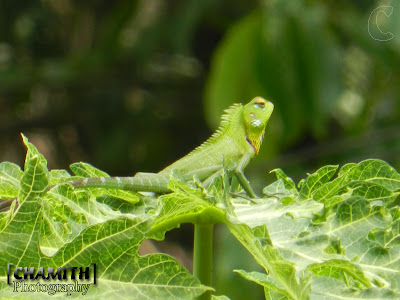Calotes calotes, the largest of Sri Lankan Agamid lizards, Length of head one and half times its breadth; snout a little longer than the orbit; forehead concave; cheeks swollen; upper head-scales unequal, smooth; canthus rostralis and supraciliary edge sharp; a row of 8 or 9 compressed spines, divided in to two groups, above the tympanum, the diameter of which is less than half that of the orbit; 9 to 11 upper and as many lower labials. Body compressed; dorsal scales large, feebly keeled, sometimes smooth, pointing backwards and upwards, as large as or a little smaller than the ventrals, which are strongly keeled and mucronate; 30 to 35 scales round the middle of the body. Gular pouch not developed; gular scales feebly keeled, nearly or quite as large as the ventrals. A short oblique fold in front of the shoulder covered with small granular scales. Nuchal and dorsal crests continuous composed of closely set lanceolate spines with smaller ones at the base; a well developed dorsal crest, in the adult male the height of the crest on the neck equals or exceeds the diameter of the orbit; on the back it gradually diminishes in size. Limbs moderate; third and fourth fingers nearly equal; fourth toe distinctly longer than third toe; the hind limb reaches to the front of the eye or beyond. Tail very long and slender.
The body color is light green or Bright grass – green dorsally with 4-5 transverse bluish white or dark green or whitish or cream cross bars, often continuoued on to the tail; The head color is changeable from light ochre, red to dark bluish green; Gular sac changes yellow to red; tail light brown; young and immature sometimes with a whitish dorso-lateral stripe.
Calotes calotes occurs throughout Sri Lankan in the plains and mid hills up to elevations of 1,500 m. This species is more abundant in the wet zone than in the dry zone. The known distribution of this species is south in India, Nicobar Islands and Sri Lanka.
This species is largely arboreal. This species is preliminary found in manmade habitats, evergreen forests and found on shrubs as well as tree trunks, close to streams. The diet comprises insects such as dipterans, hemipterans and hymenopterans.
The female digs a nest hole in the ground about 70 mm and deposits 6-12 eggs in April- September. The eggs are 18-18.5 mm x 12-12.5 mm. The Period of incubation is 79-84 days.
Conservation status: Large, widely dispersed and stable population.
Pictures






No comments:
Post a Comment